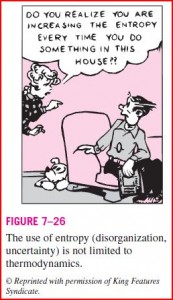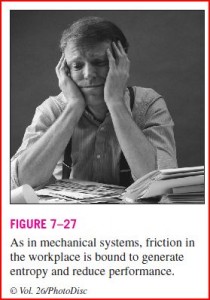The following paragraph from the “Thermodynamic An Engineering Approach” 5th Editiond [Yunus A. Cengel, and Micheal A. Boles]
 The concept of entropy can also be applied to other areas. Entropy can be viewed as a measure of disorder or disorganization in a system. Likewise, entropy generation can be viewed as a measure of disorder or disorganization generated during a process. The concept of entropy is not used in daily life nearly as extensively as the concept of energy, even though entropy is readily applicable to various aspects of daily life. The extension of the entropy concept to nontechnical fields is not a novel idea. It has been the topic of several articles, and even some books. Next we present several ordinary events and show their relevance to the concept of entropy and entropy
The concept of entropy can also be applied to other areas. Entropy can be viewed as a measure of disorder or disorganization in a system. Likewise, entropy generation can be viewed as a measure of disorder or disorganization generated during a process. The concept of entropy is not used in daily life nearly as extensively as the concept of energy, even though entropy is readily applicable to various aspects of daily life. The extension of the entropy concept to nontechnical fields is not a novel idea. It has been the topic of several articles, and even some books. Next we present several ordinary events and show their relevance to the concept of entropy and entropy
generation.
Efficient people lead low-entropy (highly organized) lives. They have a place for everything (minimum uncertainty), and it takes minimum energy for them to locate something. Inefficient people, on the other hand, are disorganized and lead high-entropy lives. It takes them minutes (if not hours) to find something they need, and they are likely to create a bigger disorder as they are searching since they will probably conduct the search in a disorganized manner (Fig. 7–26).
People leading high-entropy lifestyles are always on the run, and never seem to catch up.
You probably noticed (with frustration) that some people seem to learn fast and remember well what they learn. We can call this type of learning organized or low-entropy learning. These people make a conscientious effort to file the new information properly by relating it to their existing knowledge base and creating a solid information network in their minds.
On the other hand, people who throw the information into their minds as they study, with no effort to secure it, may think they are learning. They are bound to discover otherwise when they need to locate the information, for example, during a test. It is not easy to retrieve information from a database that is, in a sense, in the gas phase. Students who have blackouts during
tests should reexamine their study habits.
A library with a good shelving and indexing system can be viewed as a lowentropy library because of the high level of organization. Likewise, a library with a poor shelving and indexing system can be viewed as a high-entropy library because of the high level of disorganization. A library with no indexing system is like no library, since a book is of no value if it cannot be found.
Consider two identical buildings, each containing one million books. In the first building, the books are piled on top of each other, whereas in the second building they are highly organized, shelved, and indexed for easy reference.
There is no doubt about which building a student will prefer to go to for checking out a certain book. Yet, some may argue from the first-law point of view that these two buildings are equivalent since the mass and knowledge content of the two buildings are identical, despite the high level of disorganization (entropy) in the first building.
This example illustrates that any realistic comparisons should involve the second-law point of view.
Two textbooks that seem to be identical because both cover basically the same topics and present the same information may actually be very different depending on how they cover the topics. After all, two seemingly identical cars are not so identical if one goes only half as many miles as the other one on the same amount of fuel. Likewise, two seemingly identical books are not so identical if it takes twice as long to learn a topic from one of them as it does from the other. Thus, comparisons made on the basis of the first law only may be highly misleading.
Having a disorganized (high-entropy) army is like having no army at all. It is no coincidence that the command centers of any armed forces are among the primary targets during a war. One army that consists of 10 divisions is 10 times more powerful than 10 armies each consisting of a single
division. Likewise, one country that consists of 10 states is more powerful than 10 countries, each consisting of a single state. The United States would not be such a powerful country if there were 50 independent countries in its place instead of a single country with 50 states. The European Union has the potential to be a new economic and political superpower.
 The old cliché “divide and conquer” can be rephrased as “increase the entropy and conquer.”
The old cliché “divide and conquer” can be rephrased as “increase the entropy and conquer.”
We know that mechanical friction is always accompanied by entropy generation, and thus reduced performance. We can generalize this to daily life: friction in the workplace with fellow workers is bound to generate entropy, and thus adversely affect performance (Fig. 7–27). It results in reduced productivity.
We also know that unrestrained expansion (or explosion) and uncontrolled electron exchange (chemical reactions) generate entropy and are highly irreversible. Likewise, unrestrained opening of the mouth to scatter angry words is highly irreversible since this generates entropy, and it can cause considerable damage. A person who gets up in anger is bound to sit down at a loss.
Hopefully, someday we will be able to come up with some procedures to quantify entropy generated during nontechnical activities, and maybe even pinpoint its primary sources and magnitude.